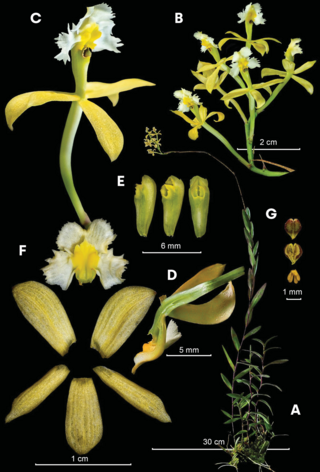
Gymnophthalmidae is a family of lizards with at least 250 species, sometimes known commonly as spectacled lizards or microteiids. They are called "spectacled" because of their transparent lower eyelids, which allow them to still see with closed eyes. As in most lizards, except geckos, these eyelids are movable. The Alopoglossidae have been recently moved from this family.

Neusticurus is a genus of gymnophthalmid lizards endemic to northern South America. They are often found near streams and are semi-aquatic. Some species formerly included in this genus are now placed in Potamites, which also are semi-aquatic inhabitants of South America.

The Cariban languages are a family of languages indigenous to north-eastern South America. They are widespread across northernmost South America, from the mouth of the Amazon River to the Colombian Andes, and they are also spoken in small pockets of central Brazil. The languages of the Cariban family are relatively closely related. There are about three dozen, but most are spoken only by a few hundred people. Macushi is the only language among them with numerous speakers, estimated at 30,000. The Cariban family is well known among linguists partly because one language in the family—Hixkaryana—has a default word order of object–verb–subject. Prior to their discovery of this, linguists believed that this order did not exist in any spoken natural language.

The Pemon or Pemón (Pemong) are indigenous people living in areas of Venezuela, Brazil, and Guyana. The Pemon people are divided into many dialects and traditions, which are; Arekuna, Kamarakoto, and Taurepang.
George Henry Hamilton Tate was a British-born American zoologist and botanist, who worked as a mammalogist for the American Museum of Natural History in New York City. In his lifetime he wrote several books on subjects such as the South American mouse opossums and the mammals of the Pacific and East Asia.
In linguistic typology, object–verb–subject (OVS) or object–verb–agent (OVA) is a rare permutation of word order. OVS denotes the sequence object–verb–subject in unmarked expressions: Oranges ate Sam, Thorns have roses. The passive voice in English may appear to be in the OVS order, but that is not an accurate description. In an active voice sentence like Sam ate the oranges, the grammatical subject, Sam, is the agent and is acting on the patient, the oranges, which are the object of the verb, ate. In the passive voice, The oranges were eaten by Sam, the order is reversed and so that patient is followed by the verb and then the agent. However, the oranges become the subject of the verb, were eaten, which is modified by the prepositional phrase, by Sam, which expresses the agent, and so the usual subject–verb–(object) order is maintained.

The Pemon language, is an indigenous language of the Cariban family spoken by some 30,000 Pemon people, in Venezuela's Southeast, particularly in the Canaima National Park, in the Roraima State of Brazil and in Guyana.
Wowetta is an indigenous village in the Upper Takutu-Upper Essequibo Region in Guyana. The village is mainly inhabited by Macushi people.

Potamites is a genus of lizards in the family Gymnophthalmidae. The genus is restricted to northern South America and southern Central America. They are semiaquatic and found near streams.
Centrosaura apodema, Uzzell's neusticurus, is a species of lizard in the family Gymnophthalmidae. It is found in Costa Rica and Panama. It is monotypic in the genus Centrosaura.
Gelanesaurus cochranae, also known commonly as Cochran's neusticurus, is a species of lizard in the family Gymnophthalmidae. The species is native to northwestern South America.

Neusticurus bicarinatus, the two-faced neusticurus, is a species of lizard in the family Gymnophthalmidae. It is found in Suriname, French Guiana, Venezuela, Guyana, and Brazil.
Neusticurus medemi, also known commonly as Medem's neusticurus, is a species of lizard in the family Gymnophthalmidae. The species is native to northern South America.
Neusticurus racenisi, known commonly as Roze's neusticurus or the common Venezuelan water teiid, is a species of lizard in the family Gymnophthalmidae. The species is endemic to northern South America.
Neusticurus rudis, the red neusticurus, is a species of lizard in the family Gymnophthalmidae. It is found in Guyana and Venezuela.
Neusticurus surinamensis, the red neusticurus, is a species of lizard in the family Gymnophthalmidae. It is native to northern South America.
Neusticurus tatei, also known commonly as Tate's neusticurus, is a species of lizard in the family Gymnophthalmidae. The species is endemic to Venezuela.
Paruima is an indigenous village of Pemon Amerindians in the Cuyuni-Mazaruni Region of Guyana. The village was founded as a mission of the Seventh-day Adventist Church. It is the only Pemon speaking community in Guyana.

Epidendrum katarun-yariku is a species of orchid in the genus Epidendrum found in the Guiana Highlands in Venezuela and Brazil. It grows on tepuis.






